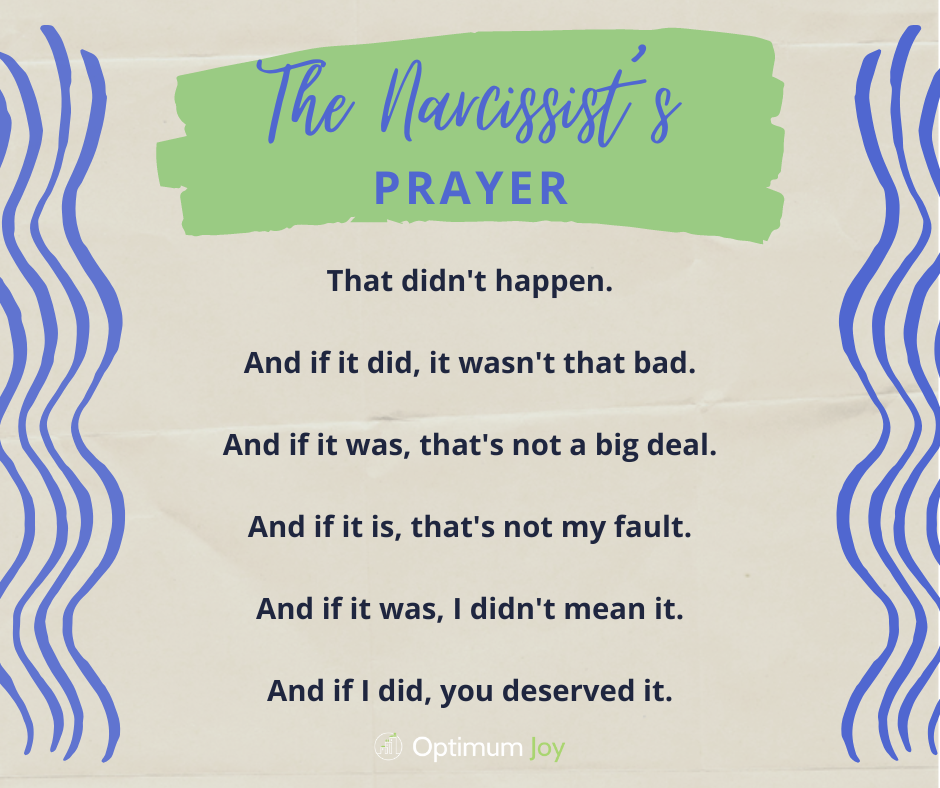The Narcissist Prayer: What it is and How to Cope
The Narcissist Prayer: What it is and How to Cope
Navigating relationships can be tough, especially when someone displays narcissistic traits.
One idea that captures the denial and manipulation often seen in these individuals is the Narcissist Prayer. This isn’t a religious prayer but a way to understand how a narcissist thinks. By learning about the Narcissist Prayer, you can gain insight into their mindset and recognize the subtle, yet harmful tactics they use.
In this article, we’ll explore what the Narcissist Prayer is, why it matters, and how you can respond to it. Whether you’re dealing with a narcissist or just want to learn more about personality disorders, this article will shed some light.

Understanding the Narcissist Prayer Poem
The Narcissist Prayer is a concept that encapsulates the denial and manipulation tactics often used by narcissists. It’s a metaphorical representation of the thought patterns and behaviors that are characteristic of individuals with narcissistic tendencies.
This concept is not a prayer in the traditional sense as it doesn’t involve any religious or spiritual practices. Instead, it’s a series of statements that reflect the narcissist’s refusal to accept responsibility for their actions. By dissecting the Narcissist Prayer, we can gain a deeper understanding of the psychological mechanisms at play. This understanding can empower us to respond effectively to such behaviors.
The Origin and Definition of a Narcissist Prayer
A Narcissist Prayer is a concept that has been widely discussed in psychology and mental health circles. The prayer itself is a series of statements that reflect the narcissist’s refusal to accept responsibility for their actions. The Narcissist Prayer is not a formal psychological term and has never been attributed to a specific author. However, it has gained recognition for its ability to succinctly capture the essence of narcissistic behavior.

Dissecting the Phrases of the Narcissist Prayer
The Narcissist Prayer is typically broken down into several phrases. Each phrase reflects a different aspect of the narcissist’s mindset and behavior.
- “That didn’t happen.”
- “And if it did, it wasn’t that bad.”
- “And if it was, that’s not a big deal.”
- “And if it is, that’s not my fault.”
- “And if it was, I didn’t mean it.”
- “And if I did, you deserved it.”
These phrases represent a progression of denial, minimization, and blame-shifting. They reflect the narcissist’s refusal to accept responsibility for their actions.
“That didn’t happen.”
Denial: The narcissist refuses to acknowledge the event, attempting to invalidate the other person’s experience and maintain control over the narrative.
“And if it did, it wasn’t that bad.”
Minimization: By downplaying the severity of the event, the narcissist aims to diminish the other person’s feelings and avoid accountability.
“And if it was, that’s not a big deal.”
Dismissal: The narcissist trivializes the impact, suggesting that the issue is insignificant, further invalidating the other person’s emotions.
“And if it is, that’s not my fault.”
Deflection: The narcissist shifts the blame away from themselves, refusing to take responsibility for their actions.
“And if it was, I didn’t mean it.”
Rationalization: The narcissist offers an excuse, framing their harmful behavior as unintentional to avoid guilt or consequences.
“And if I did, you deserved it.”
Projection and Justification: The narcissist turns the blame onto the other person, suggesting they were provoked or deserved the mistreatment, thereby justifying their actions.

Psychological Mechanisms and Implications
The Narcissist Prayer is more than just a series of statements. It’s a window into the psychological mechanisms that drive narcissistic behavior. Understanding these mechanisms can provide valuable insights into the mindset of a narcissist.
At the heart of a Narcissist Prayer are two key psychological concepts: denial and projection. These are the tools that narcissists use to manipulate their reality and avoid taking responsibility for their actions. The implications of these mechanisms are far-reaching. They can have a profound impact on the victims of narcissistic abuse; often leading to confusion, self-doubt, and emotional distress. Understanding these mechanisms and their implications is crucial for anyone dealing with a narcissist. It can empower them to respond effectively to narcissistic behaviors and protect their mental health.
Recognizing the Narcissist Prayer in Action
Recognizing the Narcissist Prayer in action requires more than just awareness—it demands an understanding of the subtle dynamics at play. Narcissists, particularly covert ones, are adept at disguising their manipulative behaviors, making it difficult to see through their tactics. These individuals often weave denial, deflection, and blame-shifting into everyday interactions so seamlessly that the manipulation can go unnoticed, leaving others questioning their own reality.
To recognize the Narcissist Prayer, it’s essential to be attuned to patterns of communication that consistently downplay or dismiss your experiences. These patterns can manifest as repeated attempts to deny events, minimize their significance, or shift responsibility away from the narcissist. By understanding these behaviors, you can begin to see the broader strategy of control and distortion that defines the narcissist’s interactions.
Identifying the Narcissist Prayer in Conversations
Identifying the Narcissist Prayer in conversations is crucial for protecting your mental and emotional well-being. In conversations with a narcissist, you may encounter a series of statements that invalidate your feelings, twist facts, or shift blame. These tactics are not always overt; they can be subtle and insidious, leaving you feeling confused and second-guessing your perceptions.
To effectively identify these manipulative patterns, it’s important to maintain a strong sense of self and reality. Pay attention to how the narcissist responds when confronted with facts or held accountable. Do they deny the occurrence of events, minimize their impact, or blame you for their actions? Recognizing these strategies can empower you to navigate the conversation with greater clarity and protect your sense of reality.
Understanding these conversational dynamics not only helps you respond more effectively but also shields you from the psychological impact of the narcissist’s attempts to manipulate and control.
Overt vs. Covert Narcissism and the Prayer
The Narcissist Prayer can be used by both overt and covert narcissists, but the way it manifests can vary. Overt narcissists are typically more blatant in their use of the prayer, often using it to deflect blame and avoid accountability in a direct and confrontational manner.
Covert narcissists, on the other hand, are more subtle. They may weave the Narcissist Prayer into their conversations in a way that is less obvious, often leaving their victims feeling confused and doubting their own perceptions.

Responding to the Narcissist Prayer
Responding to the Narcissist Prayer can be a daunting task. It requires a strong sense of self, clear boundaries, and a deep understanding of the narcissist’s manipulative tactics. However, with the right strategies, it is possible to protect oneself and maintain one’s mental health.
- The first step in responding to the Narcissist Prayer is recognizing it for what it is: a manipulative tactic used by narcissists to avoid accountability and maintain control. This recognition can empower you to respond effectively and protect your mental health.
- The second step is setting clear boundaries. This can involve asserting your perspective, refusing to engage in circular arguments, and maintaining your sense of self in the face of the narcissist’s attempts to distort reality.
- The third step is seeking support. This can involve reaching out to trusted friends or family members, joining a support group, or seeking professional help. Having a strong support system can provide validation, perspective, and emotional support.
Finally, it’s important to remember that you cannot change a narcissist. The goal is not to convince the narcissist of their wrongdoings, but to protect yourself and maintain your mental health.
Strategies for Self-Protection and Boundary Setting
Setting clear boundaries is a crucial strategy for protecting oneself when dealing with a narcissist. This can involve asserting your perspective, refusing to engage in circular arguments, and maintaining your sense of self in the face of the narcissist’s attempts to distort reality.
It’s important to remember that you have the right to your own thoughts, feelings, and perceptions. The narcissist may try to convince you otherwise, but you do not have to accept their version of reality.
Another important strategy is refusing to engage in the narcissist’s games. This can involve recognizing the Narcissist Prayer for what it is and refusing to be drawn into circular arguments or blame-shifting tactics.
Finally, it’s important to take care of your mental health. This can involve practicing self-care, seeking support, and prioritizing your own well-being over the narcissist’s demands or expectations.
The Role of Support Systems and Professional Help
Professional help can be particularly beneficial. Therapists or counselors who specialize in narcissistic abuse can provide valuable insights and strategies for dealing with a narcissist. They can also provide a safe space to process your experiences and work towards healing.
Support groups can also be a valuable resource. They can provide a sense of community and understanding, as well as practical advice and strategies for dealing with narcissists.
Finally, it’s important to remember that you are not alone. There are many resources available to help you navigate the challenges of dealing with a narcissist, and there is a community of people who understand and support you.
Conclusion: The Importance of Awareness and Self-Care
In conclusion, recognizing the Narcissist Prayer is a crucial step in dealing with a narcissist. It provides insight into the narcissist’s thought patterns and manipulative tactics, empowering you to respond effectively and protect your mental health.
However, recognizing the Narcissist Prayer is just the first step. It’s equally important to set clear boundaries, seek support, and prioritize self-care. Dealing with a narcissist can be emotionally draining, and it’s crucial to take care of your mental health throughout the process. Ultimately, dealing with a narcissist is a challenging journey, but it’s one that can lead to personal growth and empowerment.
Related Articles
-
How to Set Boundaries with Adult Step-Children: A Practical Guide
How to Set Boundaries with Adult Step-Children: A Practical Guide Navigating the complexities of blended family...
Read More -
How Long Does It Take to Become an Alcoholic?
How Long Does It Take to Become an Alcoholic? Have you ever wondered about your relationship...
Read More -
How Long Does EMDR Take for Complex Trauma?
How Long Does EMDR Take for Complex Trauma? Complex trauma can leave deep imprints on our...
Read More